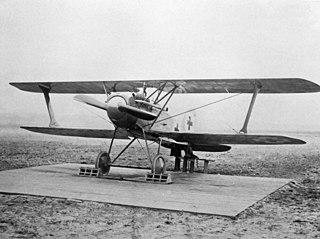
The Albatros D.IV was an experimental German fighter aircraft built and tested during World War I.

The Fokker D.I was a development of the D.II fighter. The D.I was also flown in Austro-Hungarian service as a fighter trainer aircraft under the designation B.III. Confusing the matter further, both the D.II and D.I arrived at the Front in German service at similar times, in July–August 1916. The main designer was Martin Kreutzer.

The Albatros W.4 was a German floatplane derivative of the Albatros D.I fighter with new wing and tail surfaces of greater span than the D.I. One hundred eighteen examples were built between June 1916 and December 1917. The aircraft operated in the North Sea and Baltic theatres and later served as training aircraft.

The Albatros D.X was a German prototype single-seat fighter biplane developed in 1918 in parallel with the Albatros D.IX.

The Albatros Dr.II was a German prototype single-seat fighter triplane, the sole example of which flew in the spring of 1918. It was similar in many respects to the D.X biplane, employing among other features the same 145 kW (195 hp) Benz Bz.IIIbo engine and twin 7.92 mm (.312 in) machine guns.

The Albatros D.XII was a German single-seat fighter biplane first flown in March 1918. It was the last of the Albatros fighters completed and flown before the end of World War I and had the same slab-sided fuselage seen on the Albatros D.X.
The Alter A.1 was a single-seat biplane fighter aircraft first flown in February 1917. Built by Ludwig Alter-Werke of Darmstadt to a design by Kallweit and Ketterer, the A.1 was very similar in concept to the Nieuport 11, but not an exact copy.

The Pfalz D.VIII was a German World War I fighter aircraft.
The Benz Bz.IIIb was an eight-cylinder, water-cooled, V-engine developed in Germany for use in aircraft in 1918.

The Daimler D.I was a German fighter aircraft of World War I. It was a conventional biplane design with a very small interplane gap - the top wing nearly touched the top of the fuselage. Power was provided by a Daimler D.IIIb water-cooled V-8 engine.
The Euler D.II was a German single-seat fighter, the successor to the earlier Euler D.I. The D.II was essentially a re-engined Euler D.I, the air-frame being virtually unchanged and the power plant being a 100 hp Oberusel U I 9-cylinder rotary.

The Pfalz Dr.I was a German fighter prototype of World War I. Official interest in the potential of the triplane configuration for single-seat fighters prompted Pfalz to develop the Dr.I. It underwent initial testing in October 1917, and an initial batch of 10 aircraft were shipped to the Front and arrived in April 1918.

The Daimler L14 was a two-seat, high-wing, monoplane fighter built in 1919. It was built as a two-person, aerodynamically improved version of the Daimler L11 aircraft. It was powered by the Daimler D.IIIb water-cooled V-8 engine and was armed with two 7.92 mm (0.312 in) machine guns, one forward and one rearward firing. One prototype was built. The L14V, an unbuilt mail carrier variant was offered for sale to Chile but no orders followed.

The Daimler L11 was a German single-seat, parasol-wing, monoplane fighter built during the First World War for the Imperial German Air Service. A single prototype was built in 1918, but the war ended before it could be accepted for service. The two-seat Daimler L14 was based on this aircraft.

The LFG Roland D.IX was a World War I German single seat fighter aircraft, a biplane powered by one of a new generation of powerful rotary engines. Three slightly different prototypes were built but there was no series production.

The LFG Roland D.XV was a World War I German single seat fighter aircraft, ordered as a test-bed for engine comparisons. It was distinguished from earlier Roland biplane designs by the elimination of flying wires. Two later aircraft, also called LFG Roland D.XV, were completely different designs with slab sided fuselages.

The LFG Roland D.XVI, initially designated the LFG Roland E.I, was a single-seat, single-engine, parasol wing German fighter aircraft flown close to the end of World War I. Only two were built.

The LFG Roland D.XVII was a single-seat, single-engine, parasol wing German fighter aircraft flown close to the end of World War I. Only one was built.
The Daimler CL.I was a prototype two-seat fighter built in Germany during World War I.
The Märkische D.I was a prototype single-seat fighter biplane built in the last months of World War I.
This page is based on this
Wikipedia article Text is available under the
CC BY-SA 4.0 license; additional terms may apply.
Images, videos and audio are available under their respective licenses.














